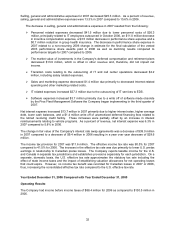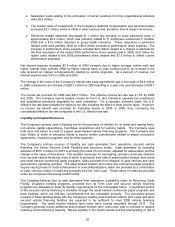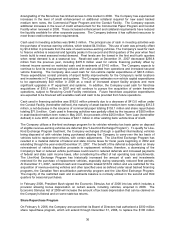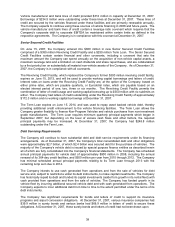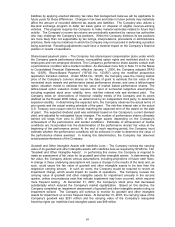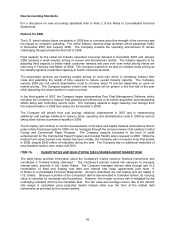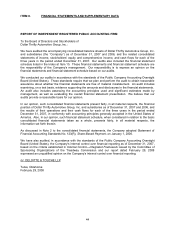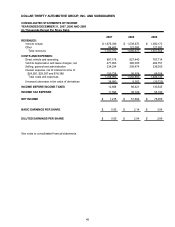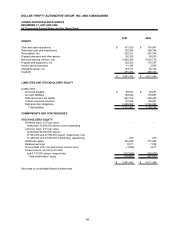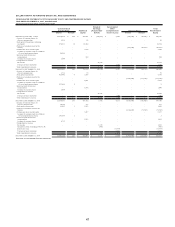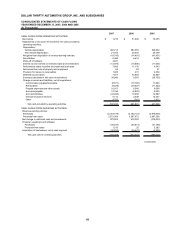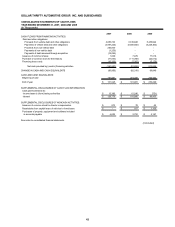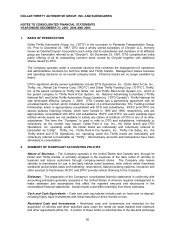Thrifty Car Rental 2007 Annual Report Download - page 48
Download and view the complete annual report
Please find page 48 of the 2007 Thrifty Car Rental annual report below. You can navigate through the pages in the report by either clicking on the pages listed below, or by using the keyword search tool below to find specific information within the annual report.Interest Rate Risk
The Company’s results of operations depend significantly on prevailing levels of interest rates because of
the large amount of debt it incurs to purchase vehicles. In addition, the Company is exposed to increases
in interest rates because a portion of its debt bears interest at floating rates. The Company estimates that,
in 2008, approximately 40% of its average debt will bear interest at floating rates. The amount of the
Company’s financing costs affects the amount the Company must charge its customers to be profitable.
See Note 10 of Notes to Consolidated Financial Statements.
Inflation
The increased acquisition cost of vehicles is the primary inflationary factor affecting the Company. Many
of the Company’s other operating expenses are also expected to increase with inflation. Management
does not expect that the effect of inflation on the Company’s overall operating costs will be greater for the
Company than for its competitors.
Critical Accounting Policies and Estimates
As with most companies, the Company must exercise judgment due to the level of subjectivity used in
estimating certain costs included in its results of operations. The more significant items include:
Vehicle insurance reserves – The Company does self-insure or retain a portion of the exposure
for losses related to bodily injury and property damage liability claims along with the risk retained
for the supplemental liability insurance program. The obligation for Vehicle Insurance Reserves
represents an estimate of both reported accident claims not yet paid and claims incurred but not
yet reported, up to the Company’s risk retention level. The Company records expense related to
Vehicle Insurance Reserves on a monthly basis based on rental volume in relation to historical
accident claim experience and trends, projections of ultimate losses, expenses, premiums and
administrative costs. Management monitors the adequacy of the liability and monthly accrual
rates based on actuarial analysis of the development of the claim reserves, the accident claim
history and rental volume. Since the ultimate disposition of the claims is uncertain, the likelihood
of materially different results is possible. However, the potential volatility of these estimates is
reduced due to the frequency of actuarial reviews and significant historical data available for
similar claims.
Vehicle depreciation expense – The Company generally purchases 50% to 60% of its vehicles as
Program Vehicles for which residual values are determined by depreciation rates that are
established and guaranteed by the manufacturers. The remaining 40% to 50% of the Company’s
vehicles are purchased without the benefit of a manufacturer residual value guaranty program.
For these Non-Program Vehicles, the Company must estimate what the residual values of these
vehicles will be at the expected time of disposal to determine monthly depreciation rates by
reviewing the projected market value for the vehicles at expected date of disposition as well as
the overall outlook for the used car market. The Company continually evaluates estimated
residual values. Differences between actual residual values and those estimated by the
Company result in a gain or loss on disposal and are recorded as an adjustment to depreciation
expense. The average life of the Non-Program Vehicles is seven to nine months. Many factors
affect the market value of used cars including increasing use of incentives by automobile
manufacturers for new vehicles, limited or excess supply of used vehicles and overall economic
conditions. The likelihood that the Company’s estimates could materially change is possible due
to the volatility of the used car market. A one percent change in the expected residual value of
Non-Program Vehicles sold during 2007 would have impacted vehicle depreciation expense, net
by $8.2 million.
Income taxes – The Company estimates its consolidated effective state income tax rate using a
process that estimates state income taxes by entity and by tax jurisdiction. Changes in the
Company’s operations in these tax jurisdictions may have a material impact on the Company’s
effective state income tax rate and deferred state income tax assets and liabilities. Additionally,
the Company records deferred income tax assets and liabilities based on the temporary
differences between the financial reporting basis and the tax basis of the Company’s assets and
40




